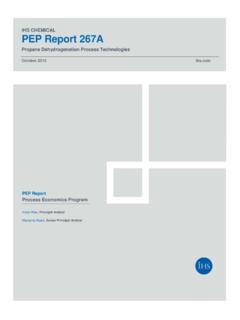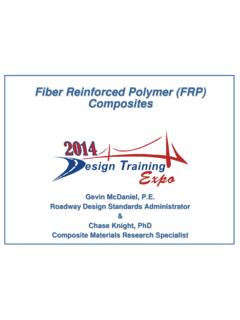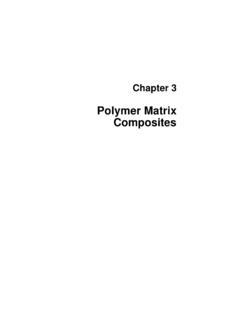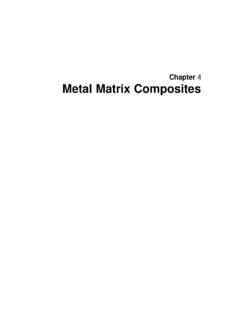Transcription of Composites in Aerospace Applications - Markit
1 Composites in Aerospace ApplicationsBy Adam Quilter, Head of Strength Analysis Group, IHS ESDUI ntroductionThe unrelenting passion of the Aerospace industry to enhance the performance of commercial and military aircraft is constantly driving the development of improved high performance structural materials. composite materials are one such class of materials that play a significant role in current and future Aerospace components. composite materials are particularly attractive to aviation and Aerospace Applications because of their exceptional strength and stiffness-to-density ratios and superior physical composite material typically consists of relatively strong, stiff fibres in a tough resin matrix. Wood and bone are natural composite materials: wood consists of cellulose fibres in a lignin matrix and bone consists of hydroxyapatite particles in a collagen matrix. Better known man-made composite materials, used in the Aerospace and other industries, are carbon- and glass-fibre-reinforced plastic (CFRP and GFRP respectively) which consist of carbon and glass fibres, both of which are stiff and strong (for their density), but brittle, in a polymer matrix, which is tough but neither particularly stiff nor strong.
2 Very simplistically, by combining materials with complementary properties in this way, a composite material with most or all of the benefits (high strength, stiffness, toughness and low density) is obtained with few or none of the weaknesses of the individual component PaperCFRP and GFRP are fibrous composite materials; another category of composite materials is particulate Composites . Metal matrix Composites (MMC) that are currently being developed and used by the aviation and Aerospace industry are examples of particulate Composites and consist, usually, of non-metallic particles in a metallic matrix; for instance silicon carbide particles combined with aluminium the single most important difference between fibrous and particulate Composites , and indeed between fibrous Composites and conventional metallic materials, relates to directionality of properties. Particulate Composites and conventional metallic materials are, nominally at least, isotropic, their properties (strength, stiffness, etc.)
3 Are the same in all directions, fibrous Composites are anisotropic, their properties vary depending on the direction of the load with respect to the orientation of the fibres. Imagine a small sheet of balsa wood: it is much easier to bend (and break) it along a line parallel to the fibres than perpendicular to the fibres. This anisotropy is overcome by stacking layers, each often only fractions of a millimetre thick, on top of one another with the fibres oriented at different angles to form a laminate. Except in very special cases, the laminate will still be anisotropic, but the variation in properties with respect to direction will be less extreme. In most Aerospace Applications , this approach is taken a stage further and the differently-oriented layers (anything from a very few to several hundred in number) are stacked in a specific sequence to tailor the properties of the laminate to withstand best the loads to which it will be subjected.
4 This way, material, and therefore weight, can be saved, which is a factor of prime importance in the aviation and Aerospace advantage of composite materials is that, generally speaking, they can be formed into more complex shapes than their metallic counterparts. This not only reduces the number of parts making up a given component, but also reduces the need for fasteners and joints, the advantages of which are twofold: fasteners and joints may be the weak points of a component a rivet needs a hole which is a stress concentration and therefore a potential crack-initiation site, and fewer fasteners and joints can mean a shorter assembly time. Shorter assembly times, however, need to be offset against the greater time likely to be needed to fabricate the component in the first place. To produce a composite component, the individual layers, which are often pre-impregnated ( pre-preg ) with the resin matrix, are cut to their required shapes, which are all likely to be different to a greater or lesser extent, and then stacked in the specified sequence over a former (the former is a solid or framed structure used to keep the uncured layers in the required shape prior to, and during, the curing process).
5 This assembly is then subjected to a sequence of temperatures and pressures to cure the material. The product is then checked thoroughly to ensure both that dimensional tolerances are met and that the curing process has been successful (bubbles or voids in the laminate might have been formed as a result of contamination of the raw materials, for example).The Use of Composites in Aircraft Design1 Among the first uses of modern composite materials was about 40 years ago when boron-reinforced epoxy composite was used for the skins of the empennages of the F14 and F15 , composite materials were used only in secondary structure, but as knowledge and development of the materials has improved, their use in primary structure such as wings and fuselages has increased. The following table lists some aircraft in which significant amounts of composite materials are used in the airframe.
6 Initially, the percentage by structural weight of Composites used in manufacturing was very small, at around two percent in the F15, for example. However, the percentage has grown considerably, through 19 percent in the F18 up to 24 percent in the F22. The image below, from Reference 1, shows the distribution of materials in the F18E/F aircraft. The AV-8B Harrier GR7 has composite wing sections and 2the GR7A features a composite rear materials are used extensively in the Eurofighter: the wing skins, forward fuselage, flaperons and rudder all make use of Composites . Toughened epoxy skins constitute about 75 percent of the exterior area. In total, about 40 percent of the structural weight of the Eurofighter is carbon-fibre reinforced composite material. Other European fighters typically feature between about 20 and 25 percent Composites by weight: 26 percent for Dassault s Rafael and 20 to 25 percent for the Saab Gripen and the EADS B2 stealth bomber is an interesting case.
7 The requirement for stealth means that radar-absorbing material must be added to the exterior of the aircraft with a concomitant weight penalty. composite materials are therefore used in the primary structure to offset this penalty. The use of composite materials in commercial transport aircraft is attractive because reduced airframe weight enables better fuel economy and therefore lowers operating costs. The first significant use of composite material in a commercial aircraft was by Airbus in 1983 in the rudder of the A300 and A310, and then in 1985 in the vertical tail fin. In the latter case, the 2,000 parts (excluding fasteners) of the metal fin were reduced to fewer than 100 for the composite fin, lowering its weight and production cost. Later, a honeycomb core with CFRP faceplates was used for the elevator of the A310. Following these successes, composite materials were used for the entire tail structure of the A320, which also featured composite fuselage belly skins, fin/fuselage fairings, fixed leading- and trailing-edge bottom access panels and deflectors, trailing-edge flaps and flap-track fairings, spoilers, ailerons, wheel doors, main gear leg fairing doors, and nacelles.
8 In addition, the floor panels were made of GFRP. In total, Composites constitute 28 percent of the weight of the A320 A340-500 and 600 feature additional composite structures, including the rear pressure bulkhead, the keel beam, and some of the fixed leading edge of the wing. The last is particularly significant, as it constitutes the first large-scale use of a thermoplastic matrix composite component on a commercial transport aircraft. The use of Composites enabled a 20 percent saving in weight along with a lower production time and improved damage A380 is about 20-22 percent Composites by weight and also makes extensive use of GLARE (glass-fibre reinforced aluminium alloy), which features in the front fairing, upper fuselage shells, crown and side panels, and the upper sections of the forward and aft upper fuselage. GLARE laminates are made up of four or more mm ( in) thick sheets of aluminium alloy and glass fibre resin bond film.
9 GLARE offers weight savings of between 3 Fighter Europe RussiaAV-8B, F16, F14, F18, YF23, F22, JSF, UCAV Harrier GR7, Gripen JAS39, Mirage 2000, Rafael, Eurofighter, Lavi, EADS Mako MIG29, Su EuropeKC135, C17, 777, 767, MD1 1 A320, A340, A380, Tu204. ATR42, Falcon 900, A300-600 General AviationPiaggio, Starship, Premier 1, Boeing 787 Rotary AircraftV22, Eurocopter, Comanche, RAH66, BA609, EH101, Super Lynx 300, S9215 and 30 percent over aluminium alloy along with very good fatigue resistance. The top and bottom skin panels of the A380 and the front, centre and rear spars contain CFRP, which is also used for the rear pressure bulkhead, the upper deck floor beams, and for the ailerons, spoilers and outer flaps. The belly fairing consists of about 100 composite honeycomb Boeing 777, whose maiden flight was 10 ten years ago, is around 20 percent Composites by weight, with composite materials being used for the wing s fixed leading edge, the trailing-edge panels, the flaps and flaperons, the spoilers, and the outboard aileron.
10 They are also used for the floor beams, the wing-to-body fairing, and the landing-gear doors. Using composite materials for the empennage saves approximately 1,500 lb in materials constitute almost 50 percent of the Boeing 787, with average weight savings of 20 excellent strength-to-weight ratio of Composites is also used in helicopters to maximize payloads and performance in general. Boeing Vertol used Composites for rotorcraft fairings in the 1950s and made the first composite rotor blades in the 1970s. Composites are used in major structural elements of many modern helicopters, including the V22 tilt-rotor aircraft, which is approximately 50 percent Composites by weight. The formability of Composites has been used to particular advantage in helicopter manufacture to reduce the numbers of component parts and therefore Research Data to Improve Engineering Design, Performance and MethodologyThe ESDU ( ) Composites Series provides a collection of Data Items and programs for use in the design of fibre-reinforced laminated composite materials.













